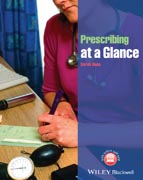
The principles of drug therapies are fundamental to medical practitioners in all branches; but are often difficult to get to grips with. Prescribing at a Glance addresses the most common uses of prescription drugs, and follows progress from dose calculation, administration to monitoring the effects in the treatments of major presenting problems. With a focus on prescribing, this user–friendly guide helps practitioners to develop crucial knowledge and skills, including establishing accurate drug histories, planning appropriate therapies, writing safe and legal prescriptions, critically appraising the prescribing of others, patient support, accessing reliable information about medicines, and detecting adverse drug reactions. Prescribing at a Glance: • Features detailed and high–quality colour illustrations throughout • Includes examples of common prescribing errors, practice prescriptions and calculations • Follows the structure of the WHO Good Prescribing Guide, and corresponds to the core curriculum of the British Pharmacological Society • Is the perfect guide to help you prepare for the Prescribing Skills Assessment (PSA) • Includes a companion website featuring interactive MCQs, available at www.ataglanceseries.com/prescribing From the series that brought you Medical Pharmacology at a Glance , and designed to help those in the later stages of their medical training become adept at the skills required for a vital yet often confusing subject – Prescribing at a Glance will help you fill in any knowledge gaps with simple step–by–step instructions, and clear, easy–to–remember guidelines. INDICE: Preface Acknowledgements Further reading Part 1 Basic principles of prescribing 1. Introduction: principles of good prescribing 2. Revision: pharmacokinetics 3. Using the British National Formulary 4. Taking a medication history 5. Reviewing current medicines Part 2 Drug selection 6. How to choose a drug 7. How to choose frequency 8. How to choose a dose 9. How to choose route of administration and formulation 10. How to choose duration of treatment, define treatment objectives and measure outcomes 11. Assessing suitability of treatment regime for patients 12. Worked Example 1: Chapters 6–11 13. Worked Example 2: Chapters 6–11 Part 3 Prescribing for special groups 14. Prescribing in liver disease 15. Prescribing in renal disease 16. Prescribing in children 17. Prescribing in the elderly 18. Prescribing in pregnancy and breast feeding Part 4 Logistics of prescribing 19. How to write a drug prescription 20. Communicating with patients about medicines 21. Therapeutic drug monitoring 22. Dealing with adverse drug reactions 23. Avoiding drug interactions (drugs, food and alternative medicines) 24. Avoiding prescribing errors Part 5 Specific drug groups 25. Using drugs for the gastrointestinal system 26. Using drugs for the cardiovascular system I 27. Using drugs for the cardiovascular system II 28. Using drugs for the cardiovascular system III 29. Using drugs for the respiratory system 30. Using drugs for the neurological system I 31. Using drugs for the neurological system II 32. Using drugs for infection 33. Using drugs for the endocrine system I 34. Using drugs for the endocrine system II 35. Using drugs for the musculoskeletal system 36. Using drugs in haematology and oncology 37. Using drugs in anaesthesia 38. An approach to common prescribing requests I 39. An approach to common prescribing requests II Appendix 1 Cross references to Prescribing at a Glance scenarios
- ISBN: 978-1-118-25731-9
- Editorial: Wiley–Blackwell
- Encuadernacion: Rústica
- Páginas: 104
- Fecha Publicación: 17/10/2014
- Nº Volúmenes: 1
- Idioma: Inglés
